Serviços Personalizados
Artigo
Indicadores
Links relacionados
-
 Citado por Google
Citado por Google -
 Similares em Google
Similares em Google
Compartilhar
Kronos
versão On-line ISSN 2309-9585
versão impressa ISSN 0259-0190
Kronos vol.35 no.1 Cape Town Nov. 2009
ARTICLES
Posters act: Namibian poster action and the photographic poster archive1
Dag Henrichsen; Giorgio Miescher; Lorena Rizzo; Jeremy Silvester
ABSTRACT
This article mainly draws from ideas and approaches developed in a recently published volume Posters in Action. Visuality in the Making of an African Nation. In contrast to most African poster historiography our argument has developed towards an understanding of posters as images in action and has linked them to their specific historical contexts of production, circulation and visual communication. While remaining critical of the assumption that posters were and are necessarily linked to urban and industrialised settings, we have acknowledged their being located within processes of negotiation of modernisation. The action approach understands posters as active agents in processes of visual communication, which involved different people and spaces at different moments in time. By doing so we have shifted the focus towards the realm of consumption and perception. The article, of course, reflects on the specific form and function of posters, but rather than focusing on image content, graphic vocabularies and genres, we have tried to understand and interpret posters in the context of specific forms of visuality emerging in Namibia throughout the twentieth century. We pay attention to varied forms of agency linked to visuals and explore how they have become meaningful through the ways they have been distributed, perceived and appropriated.
Historical posters are archival documents as they become available to us as parts of collections. Treating these collections and the specific status of posters as ephemera within them, we have engaged with an approach of exploring what we have termed archives of the poster, i.e. to link poster collections to other visual archives, such as photographic and oral ones.
Discussing various examples of historical posters from Namibia and by linking them to historical photographs and oral knowledge about them, we have reconstructed the place and role of posters in the constitution of public reading sites, among them most significantly the street. Public visual consumption was determined and regulated by segregation and apartheid policies, making access to public spaces in general and to images in particular highly contested. Nevertheless, as the article shows, despite the repressive policies of the colonial state, and linked to them a strong propagandistic bias in image production and circulation, multiple cultures of visual literacies emerged, challenging and at times undermining the containment to narrow spaces and the silencing by colonial rule.
Academic work on historical poster analysis remains comparatively new and has developed within rather confined discursive paradigms. Poster historiography reflects a dominant interest in political posters, in film and cultural posters in general and, to some extent, in commercial posters. There has been a tendency to analyse posters in terms of style, format and function. Attempts have been made, however, to establish posters as a specific, yet legitimate, form of art.2 Much of the historiography on posters has been presented in the form of catalogues, making collections of museums and archives accessible, or they have resulted from specific exhibitions and significant or commemorative events. Catalogues inevitably imply particular aesthetic conventions in the reproduction, representation and interpretation of poster images. The catalogue paradigm nurtures the idea of posters as works of art.
In this article we argue that posters should be framed within their specific historical and spatial contexts, in order to allow for a consideration of their interaction with viewers and with landscapes.3 In the recently published volume, Posters in Action: Visuality in the Making of an African Nation,4 we attempt to transcend the catalogue paradigm and its limitations by analysing posters from Namibia's colonial and recent postcolonial past. We critically engage with the assumption within African poster historiography that the medium seems to be almost inevitably linked to an urban context, to modern technologies and to capitalist modes of production and consumption. This might explain the literature's focus on political posters from liberation movements and trade unions, and on political election and voter education posters. While commercial posters have been considered in part, other types of posters (of tourism, theatre, religious and cultural events) have been neglected. When we think about African posters in terms of mass media, of urban popular culture and of public visual communication, we inevitably place our thinking about these images in a narrative of modernisation. There have, however, been attempts to address poster histories beyond the dualism of genuine African (or precolonial) and Western (or colonial and modern) visualities.5 Questions about the historical availability and accessibility of media technologies have been raised, as have those about the appropriation of new visual means and the entrenchment of various forms of representation, whether visual, oral or literal.6 Nevertheless, the linkage of posters to processes of modernisation, irrespective of how fractured and discontinuous these are considered, remains crucial. Furthermore, any analysis of their production, distribution and consumption is inextricably located within negotiations of modernising processes. Posters in Action attempts to blur the paradigm of modernity by shifting the focus away from a predominant interest in image contents, genres and aesthetics towards a perspective on action.
The 'Posters in action' approach
The paradigmatic title Posters in Action stands for a methodological approach towards posters. Here a poster is understood not as an isolated object but as an active agent in a variety of processes. These also involve different people, spaces and moments of time. Posters act. They are more simply 'a thing'. They are designed to act and trigger off reactions. The 'Posters in Action' approach deliberately moves beyond conventional poster analyses by engaging with those areas of visuality that continue to remain marginal to scholarly work. The areas include the realm of consumption and perception, the multiple ways posters have been 'read', interpreted and appropriated, and the ways in which posters as particular images have become a means of representing and remembering the past. In this article we examine over a hundred years of Namibia's poster history. We simultaneously engage with the diversity and multiplicity of Namibia's poster production and without favouring one genre of poster above the other. We thus opt for an inclusive approach, one that not only takes seriously poster history in relation to time and the astonishing variety of poster production, but does so also in relation to visuality itself. Visuality is a set of acts, events and performances and may be conceived of as an interaction between viewers and the viewed.7 Visuality needs to be historicised as well as approached with regard to its diverse qualities of form and agency.
Of course, posters as images and as objects have a specific form and function. Posters do employ particular graphic vocabularies: they can be defined and analysed according to image content and message. However, the 'Posters in Action' approach tries to move beyond simplistic classifications by asking questions about the various historical contexts, actions and actors of posters. We pay attention to the varied forms of agency linked to visuals, whether in the process of their production, distribution or consumption. In contrast to most scholarly work on historical posters, we remain critical of the assumption that posters, as conceptual images, 'speak for themselves'. We insist on a different reading and, in particular, explore how posters, like any other visuals, might have become meaningful through the ways in which they have been distributed, perceived and appropriated.
What is a poster? Scholarly work on posters usually deals with this question in terms of theories of communication or art history. We do so by thinking about posters as archival documents and reflecting on their place within collections. Two points are of importance here: firstly, posters can be documented and analysed only if they have been collected somehow and somewhere.8 While at first sight this point might seem banal, it is repeatedly acknowledged as a structural problem by poster historians. Posters fall into the archival category of ephemera, a term referring, on the one hand, to the social context of documentary production and, connected to this, to the very flimsy and marginal nature of these documents. On the other hand, the term ephemera refers to the specific problems which occur when collecting and preserving such 'grey' documents.9 Secondly, as visual archival documents, posters are either conceptualised as special collections in their own right or integrated - or otherwise associated - with other visual documents and collections such as maps, paintings and, in particular, photographs.
In our work we rely heavily on two archival collections which have strongly informed our approach to poster history. They are held by two distinct institutions, namely, the National Archives of Namibia in Windhoek and the privately run Archives of the Basler Afrika Bibliographien in Basel, Switzerland. Despite the many differences between these institutions and their collection strategies, both build poster collections in a pro-active way and both are committed to transforming their special poster archives into archives of the poster.10 This has resulted, on the one hand, in interviews being regularly conducted on posters and poster histories with former designers, activists, collectors, and consumers. On the other hand, these poster collections are complemented or linked to other visual or printed documents of all sorts in order to enhance the posters' contextualisation. We have accessed both of these archives and have used oral and photographic material extensively. The potential of such inclusive archives for the poster approach is considerable. The photographic archive, in particular, is of great relevance when it comes to contextualising posters. It has allowed us to construct a Photographic Poster Archive in order to bring across the key visual issues of our approach.
The photographic poster archive
Historical photographs blur the longstanding assumption about an almost total lack of poster circulation in Namibia up to the 1960s, and the exclusive claim to this specific visuality and form of visual communication by and for the local settler society (Figure 1). This assumption was based on the holdings of existing poster archives, which, in fact, contain almost no copies of posters produced before the 1970s. When we began our search we came across a few photographs depicting posters from earlier periods. It was only when we systematically researched the photo collection of the National Archives of Namibia that we better understood the richness and complexity of Namibia's poster history, one that goes far beyond the documents in any poster archive.11
The photographs of posters found in the National Archives of Namibia and our further quest for images from all sorts of publications uncovered a very diverse collection of photographs which depict public and private spaces. It also, very importantly, emphasises the historical importance of placards as visuals in their own right and in close association with Namibia's poster history (Figure 2). Placards are rarely collected as physical objects and are generally not considered in poster history. Despite this they have played an important role, whether as a substitute for printed posters or a medium in their own right. Interviews conducted by Kletus Likuwa and Bertha Nyambe, for example, revealed inter alia that during election campaigns in north-eastern Namibia in 1978 and 1989 whole series of posters were handwritten as printed posters were in short supply. In some cases existing posters, or slogans used on posters, were simply copied or, in other cases, the placards were produced in a very specific situation to transmit a very specific message to a local audience.12
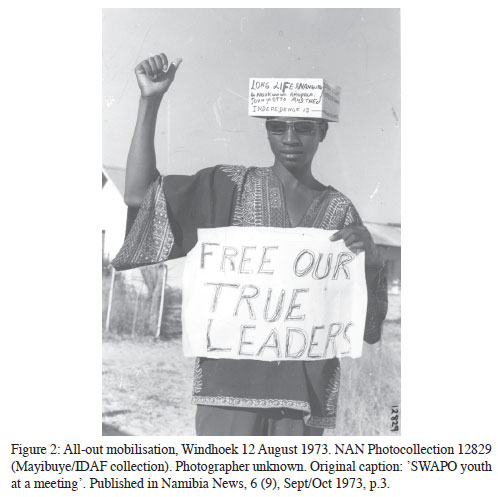
Historical photographs play an important role in the 'Posters in Action' approach. Other than oral and, sometimes, written information, photographs are often the only means to determine where and when a particular poster was used. This is, of course, crucial information with regard to visual communication and when it comes to analysing posters in action. Many photographs depict posters which never found their way into any collection (Figure 3). They remain the sole material evidence of the image in an image; an issue which is, of course, especially true for placards, which are generally beyond the collector's scope.
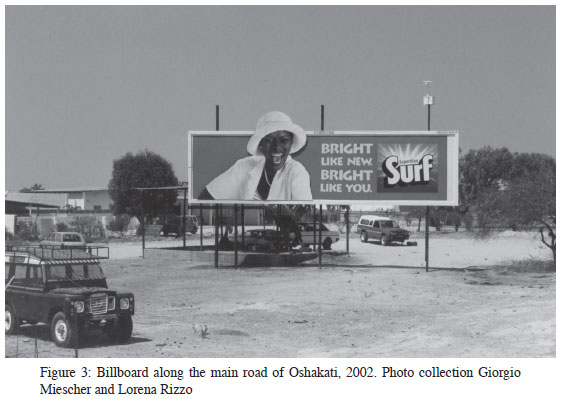
Importantly, the Photographic Poster Archive approach also undermines assumptions of poster historiographies in Europe and in the United States which imply that posters are, by definition, mass production objects. Posters in colonial Namibia, whilst perhaps having been produced en masse, were often considered single objects by the consumer or circulated in very limited numbers.13
Furthermore, photographs make posters visible in new contexts and they prolong a poster's life in ways not anticipated by the original designers. Through news photography, for example, posters and placards could circulate widely in the national and international media, through newspapers or television and also in books and catalogues. Demonstrators, for instance, were well aware of the multiplying power entailed in the liaison between the posters/placards and the camera. They used posters and placards strategically to attract the photographer's eye in order to transmit their message through the photograph to an invisible audience (Figure 4 and 5). The photographs were thus repeatedly re-contextualised in changing image-viewer constellations. Indeed, the images moved and, by doing so, ventured into a complex history of visual representation and communication which went far beyond the visual action of the 'immediate moment' to which the original posters, placards and the original snapshots made reference. It was indeed the photographic potential of posters that led us to create the Photographic Poster Archive (Figure 6).
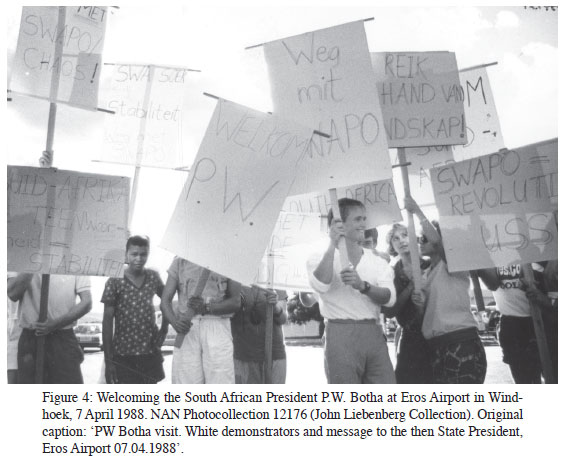
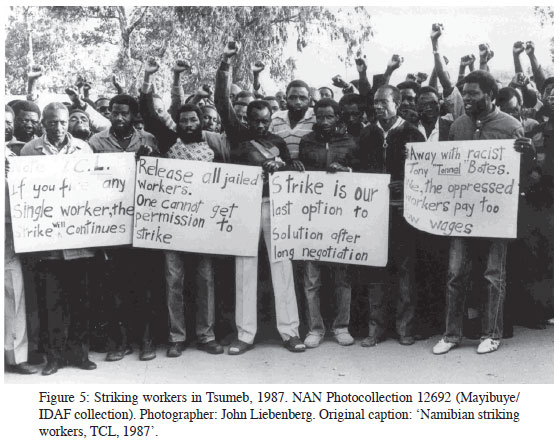
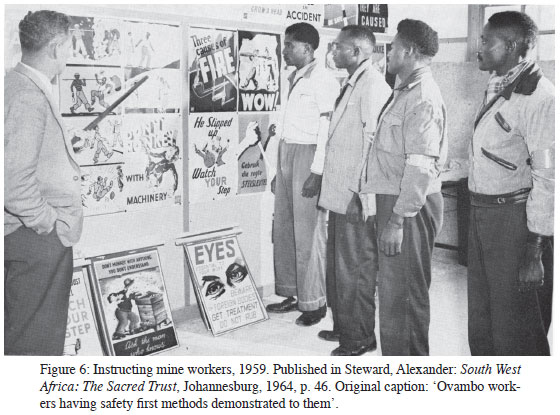
Public Reading Sites
Prominently featuring in the Photographic Poster Archive are historical images which depict public spaces, streets or other public reading sites. In part, such photography deliberately attributes agency to visuals and to spatial sites and thus suggests a public reading of visuals. One can often detect a deliberate zooming of the camera into the background of spaces in order to make visuals visible. For our purposes the question arises whether such images provide evidence of aspects of historical visual communication. What does a photograph (Figure 7) taken in the 1920s of Kaiser Street, Windhoek's main street, in which a variety of street, shop and wall advertisements can be seen, tell us about visual communication at the time?
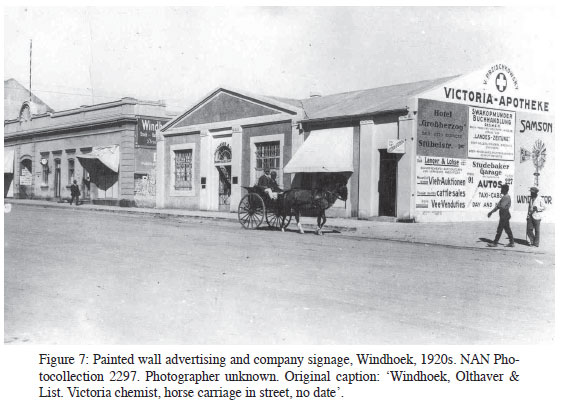
Or, to mention another prominent context of the Photographic Poster Archive, what do photographs taken inside a refugee camp in Angola, in dormitories, kitchens and classrooms and showing a variety of SWAPO posters, personal photographs and cuttings from magazines glued to walls and corridors, suggest about the circulation and selection of images for display by individuals or by the camp authorities?
Many photographs in the Photographic Poster Archive depict 'posters in action' for the purpose of depicting the truth. The Photographic Poster Archive claims to document, for example, street visuality and even visual consumption, yet this can in no way be taken for granted. Various examples testify to the 'slipperiness' of such so-called documentary photography.14 The photographic propaganda output of the Nazi movement in Namibia amongst the German settler society was particularly prominent.15 In Figure 8 we refer to a photograph from the late 1950s which depicts two African women supposedly reading or commenting on a particular poster on a cylindrical advertising pillar, the Litfass pillar, in Swakopmund. According to an interview with the photographers,16 it transpired that the two women just happened to be passing by and were 'spontaneously' asked by the photographers to enact a scene in which they read the posters, such as one for the announcement of a classical music concert. In this case, the liveliness and visibility of German colonial street visuals and street literacy was not only 'proven' in an 'exoticised' way but also framed explicitly in a posture of public reading, visual consumption and communication by members of the colonised African society.
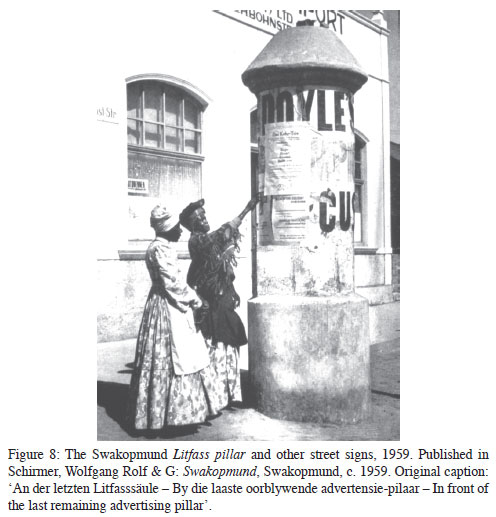
Apart from such propagandistic inclinations, the Photographic Poster Archive does allow us to say something about spaces as (public) reading sites. It transpires, for example, that the Litfass-säulen, which had been typical features of cities and towns in Germany since the second half of the nineteenth century, were erected in the colony itself from the early 1900s onwards. These pillars were situated either close to railway stations or, as in the case of Swakopmund, at junctions of main business streets. Photographs from the 1930s onwards, in turn, show the first permanent posterwalls sited, once again, next to railway stations. All these sites indicate a certain degree of spatial planning and deliberate construction of public reading sites. They also have to be regarded as attempts at systematising public visual communication. The posterwall next to Windhoek's railway station is plastered with, amongst others, several copies of the same poster, a first reference to the plastering of a repetitive poster message that, in itself, is a central characteristic of the modern agency of posters. The top left poster on this wall interestingly cries 'LEES' ('READ') to catch the eyes of passers by (Figure 9).
Obviously, a main function of these pillars and walls was to enhance the visibility of colonial culture and to emphasise urban settler modernity. The photographic depiction of them has to be viewed as an expression of this modernity. What made these spatial markers colonial in the spatial context in which they stood was their pronounced architectural and visual colonisation of space. Similar to the mapping of towns and landscapes and to the role of architecture, street signs and street visuals as means of pronounced visual and architectural colonisation of space, these pillars, boards and walls further defined colonial space and territory.
It needs to be stressed that the colonial society at large regularly passed by these sites and posters every day. However, for Africans in Windhoek, for example, up to the 1970s this was only possible during the day, given the curfew regulations which constricted their mobility The racialised nature of the colonial society and, correspondingly, the social and official control of public spaces as well as of the production and distribution of visual media, all fed into the development of a highly fractured field of everyday visual communication and experiences. Central to this was the battery of so-called petty apartheid laws relating to public spaces (townships and neighbourhoods, parks, beaches and offices of all kinds). The infamous 'Right of Admission' or 'Whites Only' signboards were only two of a plethora of apartheid signboards deployed by the colonial state and settler society. The laws and signboards acted for decades as part of a regime of regulated visual communication. This regime, as is well known, resulted in, amongst other things, a most powerful reaction on the part of the colonised population. It triggered off placards, political posters and photographs 'in counter-action'. These struggles affected not only the spatial context but also the composition of visuals. A closer look at some of the settler posters depicted in historical street photography reveals that imported posters (film advertising, for example), were censored or otherwise manipulated in order to conceal certain messages and mirages from an African public.17 'Censorship', as Robert Gordon reminded us, 'was part of the machinery used by the settlers to help maintain the illusion that they were in control and that the situation was predictable.'18
The Photographic Poster Archive requires close scrutiny in respect of the assumed documentary realism of the spaces and visuals which it depicts and also of the visual communication the photographs, in one way or another, suggest or promote. This holds true in addition for those photographs which depict public readings sites outside the settler centres. One photograph dating from the early 1960s, for example, depicts the newly erected shop of the businessman and politician Clemens Kapuuo, in Katutura, the African township of Windhoek. Another image shows the 'Akuenjanga Store' of a general dealer in northern Namibia in the early 1970s.19 Both photographs depict a variety of imported advertisements (posters, billboards and, possibly, metal plates) for cigarettes, tea, coffee and soft drinks of well-known (South African) brands (Gold Dollar, Five Roses, Koffiehuis, Sparletta), in both English and Afrikaans. Both photographs show that the advertisements allowed for (handwritten/painted) additions like names ('C. Kapuuo') and phrases ('General dealer'). The general dealer advertisement also provided additional information such as 'Foods & Wear Supp. Store. Winkel' (Figure 10 and 11).
Obviously, the overall visual construction of the shop facades was adapted to local conditions, turning both shops into particular visual reading sites of modern African consumerism outside the settler towns.20 These locations (a township, a homeland) were not simply replicating the public visual reading sites of Windhoek's settler centre but used and appropriated features in local contexts. On the one hand, this begs the question of the deployment of local literacy practices amongst an African population in Namibia which at the time still showed a high rate of formal illiteracy.21 On the other hand, both photographs could well have been taken in yet another propagandistic context, namely that of promoting the tiny modern African elite which developed from the early 1960s onwards. The second photograph, in particular, appeared amongst many other photographs as evidence of 'modern Owambo' in a propaganda volume issued by the South African Foreign Affairs Department shortly before the official declaration (in 1973) of this region as an apartheid homeland.22
Look-out
In general the Photographic Poster Archive, as discussed here, refers to colonial territory as a spatial field of viewing, reading and perceiving visuals in highly regulated and fractured, and yet also simultaneously 'shared', ways and forms. It is obvious that our methodology implies the implicit use of historical photographs as archival evidence and as documents for the use of poster (communication) analysis. We chose this approach consciously and on purpose, whilst keeping in mind the implications that this documentary paradigm has. In this way we tentatively argue for a 'revisionist' usage of photographs in historical research.
At the same time we are fully aware of the limitations of such an approach. The Photographic Poster Archive cannot tell us how ordinary people accessed and engaged with visuals such as posters, or how this affected their visual experiences.23 At best, the Photographic Poster Archive isolates a particular moment and space, and frames a very limited and partial aspect of a poster's social life and action. It depicts particular visuals in specific locations on specific occasions and, as such, allows us, if only in fragmented ways, to understand aspects of people's visual communication modes. This includes the propagandistic framework which seems to be inherent in many of the images of the Photographic Poster Archive.
A last example refers to the role and appropriation of posters in more private spaces. Another rich genre in the Photographic Poster Archive is those photographs which depict dormitories in workers' compounds or shelters in refugee camps (Figure 12). Obviously, posters on walls personalised these otherwise impersonal rooms. As people often did not own photographs, and photographs were usually too precious to be hung on walls, posters became ready substitutes. In this way posters originally intended for public places entered private spaces, touching on unfulfilled dreams and hopes, particularly in places where daily life was difficult and impersonal. With regard to visual décor they seem to have created in-between rooms, generating a particular, personalised and yet shared imagery. In many ways the Photographic Poster Archive reconstructs such shared imagery.
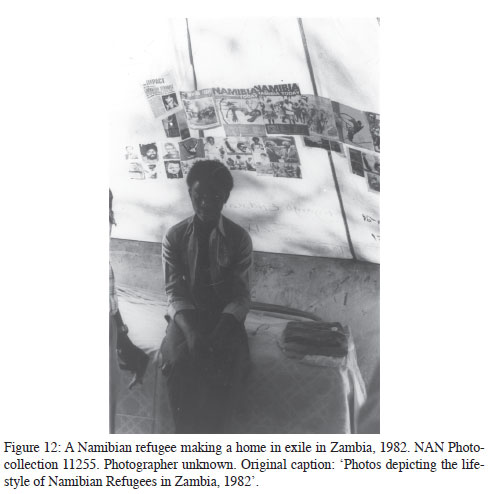
DAG HENRICHSEN is a historian and researcher/archivist at the Basler Afrika Bibliographien in Basel, Switzerland. He has worked and published on nineteenth and twentieth century Namibian history.
GIORGIO MIESCHER is a historian and researcher/archivist at the Basler Afrika Bibliographien in Basel, Switzerland. He has recently completed a PhD thesis onthe history of the Red Line in Namibia and has published on twentieth century Namibian history.
LORENA RIZZO is a historian based at the History Department of the University of Zürich. She has recently completed a PhD on gender and colonialism in northwestern Namibia in the late nineteenth and early twentieth century and has published on visual and gender history.
JEREMY SILVESTER is a historian and director of the Museums Association of Namibia in Windhoek. He has worked and published on twentieth century Namibian history.
1 This article summarises key issues which are discussed extensively in the recently published book: Giorgio Miescher, Lorena Rizzo and Jeremy Silvester eds., Posters in Action: Visuality in the Making of an African Nation (Basel: Basler Afrika Bibliographien, 2009). [ Links ] The book, the result of a long transnational collaborative research association between Namibian and Swiss students and historians, offers elaborative essays and, in one part, an extensive photo section which we term the Photographic Poster Archive. Most of the images in this essay are taken from the book.
2 E.g. Judy Seidman, Red on Black. The Story of the South African Poster Movement (Johannesburg: STE Publishers, 2007) [ Links ]
3 See Miescher et al, Posters in Action: 6-15 (introduction).
4 Ibid.
5 See Tobias Wendl's work on African advertising e.g. Tobias Wendl,ed., Afrikanische Reklamekunst (Wuppertal: Peter Hammer, 2002)) and Timothy Burke's on consumption in modern Zimbabwe (e. [ Links ]g. Timothy Burke, Lifebuoy Men, Lux Women: Commodification, Consumption and Cleanliness in Modern Zimbabwe (Durham NC: Duke University Press, 1996)). [ Links ]
6 Paul S. Landau and Deborah D. Kaspin, eds, Images & Empires. Visuality in Colonial and Postcolonial Africa (Berkley: University of California Press, 2002); [ Links ] Wolfgang Hartmann, Patricia Hayes and Jeremy Silvester, eds., The Colonising Camera: Photographs in the Making of Namibian History (Cape Town/Windhoek/Athens: University of Cape Town/Out of Africa/Ohio University Press, 1998). [ Links ]
7 Nicholas Mirzoeff, An Introduction to Visual Culture (London: Routledge, 1999): 1-33 ('Introduction'): here 13. [ Links ]
8 See, for example, HSK 13, ed., Hoch die Kampf dem. 20 Jahre Plakate autonomer Bewegungen (Hamburg/Berlin/Göttingen: Verlag Libertäre Assoziation/Verlag der Buchläden Schwarze Risse/Rote Strasse, 1999). [ Links ]
9 Giorgio Miescher and Lorena Rizzo, 'Archiving Ephemera: Namibian Posters as Heritage', Paper presented at 'Issues in Museum and Heritage Studies', University of the Western Cape, Cape Town, 2005; [ Links ] The Charted Institute of Library and Information Professionals, Ephemera: the Stuff of History: Report on the Working Party on Ephemera Set Up by CILIP (the Chartered Institute of Library and Information Professionals (Thatcham, 2003). [ Links ] In German, ephemera are also called Graue Literatur - 'grey literature'.
10 On the BAB collection see Giorgio Miescher and Dag Henrichsen, African Posters: A Catalogue of the Poster Collection in the Basler Afrika Bibliographien (Basel: Basler Afrika Bibliographien, 2004), 8-15; [ Links ] on the poster collection in the National Archives of Namibia (as well the one of the National Library of Namibia) see Werner Hillebrecht, 'Collecting Posters in Namibia'. Paper presented at the workshop on 'Posters in Namibian History' at the University of Namibia, 1 June 2002. [ Links ] Cataloguing of the BAB collection started in 1995, of the NAN collection in 1993.
11 This systematic research was done with the help of Anna Vögeli in 2007.
12 See Kletus Muhena Likuwa and Bertha Nyambe, 'Posters, T-Shirts and Placards: Images and popular mobilisation in Rundu during the liberation struggle, in Miescher et al, Posters in Action: 87-99. [ Links ]
13 Giorgio Miescher, Lorena Rizzo and Jeremy Silvester, 'Visualizing Namibia: Posters and publics before independence', Critical Interventions: Journal of African art history and visual culture, 2 (2008):102-124. [ Links ]
14 See, for example, John Tag, 'Evidence, truth and order: a means of surveillance', in Jessica Evans and Stuart Hall, eds., Visual Culture: The Reader (London: SAGE, 2005 (originally 1999): 244-274, esp. 264ff. [ Links ]
15 See Dag Henrichsen, '"Lees!,"' : Historical photography, public reading sites and visuals', in Miescher et al, Posters in Action: esp. 45-50. [ Links ]
16 Rolf and G. Schirmer operated their shop Photo Holler in the then Kaiser Wilhelm Street in Swakopmund from the 1950s until around 1991. Telephone interview with Dag Henrichsen, April 2006.
17 For more details see Henrichsen, '" Lees "': 53f.
18 Robert Gordon, 'The battle for the bioscope in Namibia'. African Identities, 3, 1, (2005): 45. [ Links ]
19 The name 'Akuenjanga' refers to a village between Ongwediwa and Okatana. Thanks to Martha Akawa and Timo Mashuna for providing this information.
20 On commercialism in northern Namibia with reference to western cloth through (retail) shops see Vilho Shigwedha: 'The pre-colonial costumes of the Aawambo: Significant changes under colonialism and the construction of post-colonial identity', in Lovisa Nampala and Vilho Shigwedha, Aawambo Kingdoms, History and Cultural Change. Perspectives from Northern Namibia (Basel: P. Schlettwein Publishing, 2006): 221ff. [ Links ]
21 On this see also the more elaborate reflections in Henrichsen, '"Lees"': 55.
22Owambo (Pretoria: Department of Foreign Affairs, 1971). [ Links ]
23 See Ute Papen, TVs, textbooks and tour guides: Uses and meanings of literacy in Namibia (University of London, PhD, 2002): 69. [ Links ]














